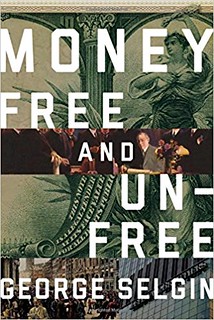
PREV ARTICLE
NEXT ARTICLE
FULL ISSUE
PREV FULL ISSUE
NEW BOOK: MONEY FREE AND UNFREEAuthor and E-Sylum reader George Selgin has authored a new book on the history and future of alternative currencies. Here's a review from the urban policy magazine
City Journal. -Editor
For a century and a half, Scotland’s was the most innovative banking system ever devised. It was also safe: between 1809 and 1835, the bank-failure rate in England was five times that of Scotland. Scottish innovations included branch banking, interbank banknote clearing, interest-bearing deposits, overdrafts, lines of credit, multicolored banknotes, and banknotes printed on both sides. And the Scottish banking system was an early adopter of small-denomination banknotes as a source of financing. No wonder that Charles Calomiris and Stephen Haber hail this period in Scotland as the golden age of banking. Throughout the nineteenth century in the United States, state and federal banknotes circulated as money. Banks and bank-owned clearinghouses policed one another, with the notes of riskier or remoter banks trading at a discount. Banks behaved well at the cost of losing their reputation—and the value of their currency—among other banks, clearinghouses, and the public. During the Civil War, the federal government levied a 10 percent tax on state-chartered bank notes, causing most banks to convert to federal charters. Washington mandated that federal banks hold $100 of government bonds for every $90 issued. Until just before World War I, the American economy experienced gentle monetary deflation and suffered a few recessions, but on balance, the economy performed well. The U.S. established the Federal Reserve System in 1913, and in the century since, the Fed has amassed ever greater power and discretion. Selgin argues that the Fed’s record on price stability, economic growth, and economic stability has been worse than predecessor systems. For instance, a basket of consumer goods selling for $100 in 1790 cost $108 in 1913; in 2008, that same basket cost $2,422. “No major institution in the U.S.,” Milton Friedman observed, “has so poor a record of performance over so long a period, yet so high a public reputation.” The need for a central bank was hotly disputed throughout much of American history. In 1836, Andrew Jackson’s administration chose not to renew the charter for the Second Bank of the United States. “Monopoly currency supply is more a cause of, than a cure for, financial fragility,” Selgin contends, because the central bank has an incentive to meddle in the economy by debasing the currency. Central banks enjoying a monopoly on currency—and often being the main financial regulator—have a vested interest in the monetary status quo. Moreover, central banks have no natural self-corrective mechanism and are therefore themselves destabilizing. See the complete review online for more topic, including the Federal Reserve and crypto-currencies. -Editor
To read the complete article, see: For more information, or to order, see: Wayne Homren, Editor The Numismatic Bibliomania Society is a non-profit organization promoting numismatic literature. See our web site at coinbooks.org. To submit items for publication in The E-Sylum, write to the Editor at this address: whomren@gmail.com To subscribe go to: https://my.binhost.com/lists/listinfo/esylum All Rights Reserved. NBS Home Page Contact the NBS webmaster 
|
